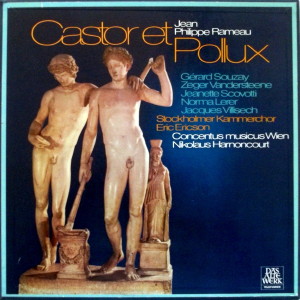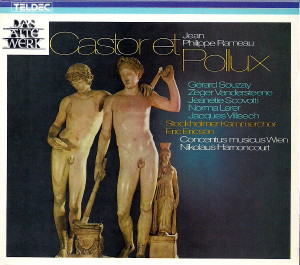 |
4 LP -
SAWT 9584/87-A - (p) 1972
|

|
| 3 CD -
8.35048 ZB - (c) 1987 |
|
Jean-Philippe
Rameau (1683-1764)
|
|
|
|
|
|
|
|
| Castor et Pollux |
|
|
|
|
|
|
|
| Prologue |
|
27' 00" |
|
- Ouverture
|
3' 23" |
|
A1 |
- Scène I
|
11' 35" |
|
A2 |
- Scène II
|
12' 10" |
|
A3 |
| Acte I |
|
27' 40" |
|
| - Scène I |
2' 36" |
|
B1 |
| - Scène II |
5' 45" |
|
B2 |
| - Scène III |
4' 28" |
|
B3 |
| - Scène IV |
9' 22" |
|
B4 |
| - Scène IV |
5' 28" |
|
B5 |
| Acte II |
|
30' 33" |
|
| - Scène I |
2' 54" |
|
C1 |
| - Scène II |
4' 34" |
|
C2 |
| - Scène III |
1' 58" |
|
C3 |
| - Scène IV |
6' 33" |
|
C4 |
| - Scène V |
14' 35" |
|
D |
| Acte III |
|
17' 55" |
|
| - Scène I |
2' 22" |
|
E1 |
| - Scène II |
2' 36" |
|
E2 |
| - Scène III |
4' 43" |
|
E3 |
| - Scène IV |
6' 22" |
|
E4 |
| - Scène V |
1' 21" |
|
E4 |
| Acte IV |
|
19' 55" |
|
| - Scène I |
4' 09" |
|
F1 |
| - Scène II |
12' 13" |
|
F2 |
| - Scène III |
0' 53" |
|
F3 |
| - Scène IV |
9' 48" |
|
F4 |
| Acte V |
|
36' 19" |
|
| - Scène I |
2' 03" |
|
G1 |
| - Scène II |
2' 48" |
|
G2 |
| - Scène III |
1' 08" |
|
G3 |
| - Scène IV |
5' 36" |
|
G4 |
| - Scène V |
0' 30" |
|
G5 |
| - Scène VI |
2' 15" |
|
G6 |
- Scène VII (inizio)
|
4' 54" |
|
G7 |
| - Scène
VII (fine) |
17' 07" |
|
H |
|
|
|
|
Jeanette Scovotti,
Minerve, Télaïre
|
|
Märta Schéle,
Venus, Suivant d'Hébé, Une Ombre,
Une Planète
|
|
Zeger
Vandersteene, L'Amour, Castor
|
|
Rolf Leanderson,
Mars, Athlèt
|
|
| Norma Lerer,
Phébé |
|
| Gérard Souzay,
Pollux |
|
| Jacques Villisech,
Jupiter |
|
| Helga Reiter,
Suivant d'Hébé |
|
| Sven-Erik
Alexandersson, Le Grand-Prȇtre
de Jupiter, Athlèt |
|
|
|
| Stockholmer
Kammerchor / Eric Ericson, Leitung |
|
(Chœur des
Arts et des Plaisirs / Chœur des
Spartiates
/ Chœur des
Plaisirs célestes / Petit chœur
des Suivantes d'Hébé / Chœur des
Démons / Chœur des
Ombres heureuses
/ Chœur des
Astres)
|
|
| Continuo:
Herbert Tachezi, Cembalo /
Nikolaus Harnoncourt, Violoncello |
|
|
|
Concentus Musicus
Wien und Instrumentalsolisten
"Musica Holmiae" *
|
|
| -
Alice Harnoncourt, Barockvioline |
-
Hermann Höbarth,
Barockcello
|
|
| -
Walter Pfeiffer, Barockvioline |
-
Bengt Ericson, Barockcello * |
|
-
Lars Fryden, Barockvioline *
|
-
Eduard Hruza, Violone |
|
| -
Tullo Galli, Barockvioline * |
-
Göte Nylén, Violone * |
|
-
Peter Schoberwalter,
Barockvioline
|
-
Leopold Stastny, Traversflöte,
Blockflöte
|
|
| -
Wilhelm Mergl, Barockvioline |
-
Gottfried Hechtl, Traverflöte
|
|
| -
Josef de Sordi, Barockvioline |
-
Ulf Bergström, Traversflöte *
|
|
| -
Per Sandklef, Barockvioline * |
-
Jürg Schaeftlein, Blockflöte,
Barockoboe |
|
| -
Björn Sjögren, Barockvioline * |
-
Paul Hailperin, Barockoboe, Oboe
d'amore |
|
| -
Martin Bylund, Barockvioline * |
-
Milan Turkovic, Barock fagott
|
|
| -
Lars Stegenberg, Barockvioline * |
-
Otto Fleischmann, Barock fagott
|
|
| -
Kurt Theiner, Barockviola |
-
Josef Spindler, Naturtrompete |
|
| -
Nikolaus Harnoncourt, Tenorviola,
Barockcello |
-
Herbert Tachezi, Cembalo |
|
|
|
| Nikolaus Harnoncourt, Gesamtleitung |
|
|
Luogo e data
di registrazione
|
| Stoccolma (Svezia) &
Vienna (Austria) - febbraio e maggio
1972 |
|
Registrazione
live / studio
|
| studio |
Producer / Engineer
|
| Wolf Erichson |
Prima Edizione
CD
|
Teldec "Das Alte Werk" -
8.35048 ZB - (3 cd) - 54' 49" + 48' 02"
+ 63' 28" - (c) 1987 - AAD
|
Prima
Edizione LP
|
Telefunken "Das Alte Werk" -
SAWT 9572/75-A - (4 lp) - 54' 40" + 30'
33" + 37' 50" + 36' 19" - (p) 1972
|
|
|
Performance
Practice
|
Contrary
to instrumental music, which
was usually quite accurately
notated, composers wrote
their operas right from the
beginning only in a sketchy
form. In this way they
propably wanted to allow
conductors full scope for
their creative autonomy and
at the same time freedom to
optimally adjust the work to
whichever conditions
prevailed. This is to be
found in the Italian operas
of Monteverdi and Cavalli
and, too, in the stage works
of Lully and his successors.
Printed scores usually only
show 2 or 3 instrumental
voices while the solo vocal
parts are written out fully.
We know, however, that the
orchestra had normally five
voices and therefore the
middle voices and the
instrumentation had to be
first worked out and written
in. Now from Parisian
performances there are many
preserved orchestral parts
so that many accurate scores
can be reconstructed of
various works. It is of
course very difficult to see
from this what part the
composer played. In many
cases the parts were
probably written by the
musicians themselves or by
clever arrangers perhaps
from the composer’s
“workshop”.
Most of Rameau’s operas have
also been handed down to us
in this way. There are two
printed scores of “Castor
and Pollux", one of the
original version of 1737 and
one of the second version of
1754, both being only
sketchily written. The
overture is only written on
two lines and there are only
a few written remarks which
give a clue to the
instrumentation (in the
Allegro there is
occasionally written
“violons”, “hautbois”,
“bassons” or “tous”). The
flute and oboe parts are now
and then written out in full
but the middle voices never.
The dynamics are quite
exactly marked even with
intermediate values. - The
preserved orchestral parts
of the first performance
allow a mainly five-voiced
score with two violins to be
constructed, a score which
makes a very authentic
impression. Judging from the
quality I would like to
assume that the middle
voices and the details
of instrumentation come from
Rameau or were at least
supervised by hirn. The few
directions in printed
score-sketches have in these
voices been exactly
followed. There are, too,
many arrangements, which
diverge from this edition,
which were obviously
not sanctioned by Rameau
(their instrumentation
deviates too much from his
directions) which show, however,
how big the scope was the
performers at that time had.
(There is for example, one
score in which apart from
flutes, oboes and bassoons
there appear also horns
which certainly did not lie
in the intention of the
composer. In the same
version bassoon
solos written by Ramcau are
given to the violas etc.)
Apart from notation and
instrumentation there is
posed in every Baroque opera
the question of
improvisation and
ornamentation. In this
respect the French were far
stricter than the Italians
and tolerated no free ornamentation
whatsoever hut only the
exactly coded “agréments” of
instrumental music. This
demanded an extremely
refined and studied
performance. In every case
it must be
decided which kind of
ornament is intended (before
or on the beat, long or
short suspension, with or
without termination etc.).
Rameau said: “...even if an
ornament is performed well
and a “certain something",
which makes all the
difference, is missing...
too much or too little, too
early or too late, longer or
shorter “belated notes”
(suspensions), with notes
that increase or decrease in
volume, in one word that
last bit of precision... if
it is even missing only
once,then every ornament
becomes boring...” These
ornaments were taken from
instrumental music and used
for vocal music, even in
choral passages. This
recorded performance has
tried to find
the spirit and sense of
every ornament and to
perform them with that
“certain something”
which was so important to
Rameau.
In creating the recordings
on this record we have tried
to convey at least a minimum
of operatic scenery. Of
course we didn’t want to
have the characters walking
from one imaginary spot on
the stage to the other but
we did want to give them a
definite place in their
respective scenes even
occasionally implying a
necessary movement. In the
“divertissements” in the
Prologue and in the 2nd, 4th
and 5th Acts we have
included two small
additional orchestras which
as it were are positioned to
the left and right of the
stage and which play some of
the dances but also
accompany many of the choruses
and solos. This practise
corresponds, of course, to
old theatrical usage and is
intended to make the various
levels of meaning of the
main action and
divertissement clearly
audible.
Nikolaus
Harnoncourt
|
|
Nikolaus
Harnoncourt (1929-2016)
|

|

|
|